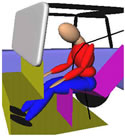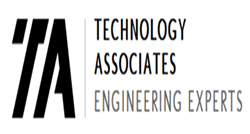 In many vehicle accident investigations, it is necessary to know not only the speeds and motions of the vehicles involved, but the causes of injuries suffered by their occupants as well. Such investigations seek to answer questions regarding occupant ejection, effects of seatbelt use, airbag deployment and body-interior impacts. Such answers can sometimes be found through simple analyses, or they may require advanced three-dimensional simulations and computer modeling techniques. Once an analysis of this type is complete, it is often necessary to generate drawings or animations to communicate the findings to a judge, jury or mediator.
In many vehicle accident investigations, it is necessary to know not only the speeds and motions of the vehicles involved, but the causes of injuries suffered by their occupants as well. Such investigations seek to answer questions regarding occupant ejection, effects of seatbelt use, airbag deployment and body-interior impacts. Such answers can sometimes be found through simple analyses, or they may require advanced three-dimensional simulations and computer modeling techniques. Once an analysis of this type is complete, it is often necessary to generate drawings or animations to communicate the findings to a judge, jury or mediator.
Expertise
We have significant experience in many aspects of occupant dynamics including:
- Determining the effect of seatbelt slack and stretch and airbag deployment upon occupant injuries
- Determination and calculation of Head Injury (HIC) and other injury criteria
- Computer simulation and animation
Questions Answered
Through scientific analysis, we can help you answer pertinent questions such as:
- Are the alleged injuries consistent with the evidence?
- Was the driver/passenger wearing a seatbelt?
- Would the use of a seatbelt or airbag deployment have prevented or reduced the occupant's injuries?
Case Examples
SUV Rollover Ejection:
A woman driver was seriously injured when her SUV was struck sideways by a car causing her vehicle to roll over. The SUV driver was ejected because she was unbelted. The defense claimed that, based upon statistical studies, she would not have been injured if she had been belted. We demonstrated that her major injuries were caused by her impact with the door interior, which would have been inflicted even if she had been belted and was not ejected. The case settled in the plaintiff's favor.
Two Car Collision:
Two cars collided at an intersection because one driver was inattentive while crossing the intersection at high speed. Her vehicle collided with the side of the other vehicle and she was injured even though her airbag deployed. She later admitted that she was not wearing her seatbelt, but was still seeking compensation for her injuries. We reconstructed the accident and determined that if she had been wearing a seatbelt, she would not have been seriously injured.
Kristopher J. Seluga, PE, is a Mechanical Engineering, Accident Reconstruction, Biomechanics, and Safety Expert with over 20 years of experience. He received his Bachelor's and Master's degrees from the Mechanical Engineering department at MIT where he worked on the development of novel three-dimensional printing technologies. Mr. Seluga is also a licensed Professional Engineer in New York and Connecticut, and has served as a member of the ANSI engineering committee for the Z130.1 and Z135 standards for golf cars and PTV's. His research interests and peer reviewed publications span the topics of Motor Vehicle Dynamics, Product Safety, and Biomechanics.
©Copyright - All Rights Reserved
DO NOT REPRODUCE WITHOUT WRITTEN PERMISSION BY AUTHOR.



 In many vehicle accident investigations, it is necessary to know not only the speeds and motions of the vehicles involved, but the causes of injuries suffered by their occupants as well. Such investigations seek to answer questions regarding occupant ejection, effects of seatbelt use, airbag deployment and body-interior impacts. Such answers can sometimes be found through simple analyses, or they may require advanced three-dimensional simulations and computer modeling techniques. Once an analysis of this type is complete, it is often necessary to generate drawings or animations to communicate the findings to a judge, jury or mediator.
In many vehicle accident investigations, it is necessary to know not only the speeds and motions of the vehicles involved, but the causes of injuries suffered by their occupants as well. Such investigations seek to answer questions regarding occupant ejection, effects of seatbelt use, airbag deployment and body-interior impacts. Such answers can sometimes be found through simple analyses, or they may require advanced three-dimensional simulations and computer modeling techniques. Once an analysis of this type is complete, it is often necessary to generate drawings or animations to communicate the findings to a judge, jury or mediator. 







